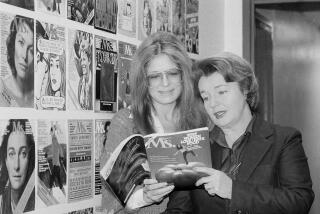Women Stayed Home in the Cold War
- Share via
MINNEAPOLIS — The latest chapter of better U.S.-Soviet relations is good news for American women. The Cold War always had a chilling effect on the momentum for women’s rights.
The connection is curious but real; anti-communism in the United States has traditionally been directed against perceived internal dangers, as well as external enemies. The Soviet Union has loomed as an abstract symbol of what we might become if we turned “soft.”
In the early years of the Cold War, a broad-based consensus of liberals and conservatives called for the “moral rearmament” of America. Observers had been concerned about the nation’s morals since World War II, when changes in human relations and sexual mores appeared as threatening to the American Way of Life as communism itself. No wonder, then, that Joseph McCarthy and his followers attacked “pinkos” and homosexuals with equal vigor; America could only be strong, it seemed, if men were men and women were housewives.
The current 1950s nostalgia craze obscures the fact that it was a peculiar decade, marked by the Cold War consensus and widespread conformity to a powerful family ideology. The central kinship between women’s domesticity and Cold War values found its most explicit expression in the famous “kitchen debate” between then-Vice President Richard M. Nixon and Soviet Premier Nikita S. Khrushchev at the American National Exhibition in Moscow in 1959. Nixon extolled the superiority of American capitalism over communism, pointing to the model home where a woman demonstrated the wonders of push-button household appliances. America, proclaimed Nixon, wants to make the life of housewives easier. Khrushchev scorned the capitalist image of women and expressed pride in productive Soviet female workers.
For Nixon, the attractive homemaker surrounded by labor-saving appliances symbolized the American Way of Life. Unlike Soviet women, portrayed in the American press as hard-working and unattractive, American women could be glamorous stay-at-homes who purchased consumer goods, tended suburban houses and reared future citizens.
Nixon’s words went beyond mere propaganda, for during the early years of the Cold War, Americans married at younger ages--and in greater numbers--than ever before. They also reversed a 150-year decline in the birth rate, creating the so-called baby boom.
Common wisdom suggests that Americans, weary from the years of Depression and war, wanted nothing more than to settle into affluent family life. But prosperity alone does not explain this massive rush into domesticity.
World War II brought women, including Rosie the Riveter, into the public arena but it also made women, especially unmarried women, suspect. Single women had enjoyed a modicum of respectability during the first four decades of the century; suddenly they were not to be trusted. Sex was the issue. Soldiers were warned that single women were sexual predators out to sap them of their money and vigor; public health organizations warned that “victory girls” could inflict venereal diseases upon unsuspecting GIs. Posters pictured sexy women arm-in-arm with Hitler and Mussolini as the “troika” that would defeat the Allies. After the war, popular movies and novels like Mickey Spillane thrillers depicted powerful women whose sexuality and economic shrewdness destroyed men in their path, or whose seductiveness tempted weak men to give atom secrets to Soviet spies.
At the same time, anti-communist crusaders scrutinized individual sexual behavior for evidence of potential security risks. National figures such as FBI Director J. Edgar Hoover warned that sons of working, neglectful or sexually frustrated mothers would become juvenile delinquents--or would be psychologically unfit to be soldiers. The federal Civil Defense Administration expanded the argument by claiming that homemakers could protect their families against nuclear annihilation with first aid, well-stocked basement shelters and skill in cooking-- “with bricks and rubble”--to feed their families after an atomic attack.
Beneath these notions was a deep fear of women’s economic and sexual independence. The best way to contain their career aspirations was to professionalize homemaking; the best way to contain their sexual emancipation was to encourage early marriage and to sexualize the home. Female sexuality unleashed within marriage would strengthen the family; outside marriage, it was seen as a destructive force.
At the same time, federal subsidies encouraged early marriage by supporting suburban developments containing thousands of inexpensive houses designed to facilitate child-rearing. Government agencies, arguing that urban centers were likely targets of nuclear attack, gained approval for new highways and decentralized industries to help spread the population into family-centered suburbs.
Most powerful of all were the child-rearing experts, social scientists and psychologists who claimed that if women did their jobs well in the home, they would raise the citizens and scientists who would guarantee America’s future security. But if they pursued careers or sexual relationships outside the home, then the nation would be filled with juvenile delinquents, degenerate men, crime and chaos.
Did women accept this ideology just because they did not want to be considered security risks? Hardly. The postwar years offered very few viable alternatives for women to achieve economic independence and professional achievement. The best route to financial security and social standing was marriage to a successful breadwinner. So women carved out a place for themselves in the domestic ideology by infusing their job with dignity and professional standards, and by having several children who would, they hoped, build a better future.
As it turned out, these women did not necessarily find fulfillment in the domestic role they embraced. Their own baby-boom children grew up to challenge the family ideology as well as the Cold War assumptions of their parents. Young people returned, instead, to trends their grandparents had once furthered: fewer children, more single individuals and grass-roots political activism against the status quo. As young Americans in the ‘60s and ‘70s shook loose from the imperatives of the Cold War, they also rejected the sexual taboos of the past, opposed the nation’s foreign policy and breathed new life into the feminist movement. The years of detente in the 1970s brought national affirmative-action policies, legalized abortion, pay-equity measures--and a crowd of women entering male-dominated occupations.
It is no historic accident that the Reagan years, which revived the rhetoric of the Cold War, also unleashed an anti-feminist backlash against the rising tide of women’s rights. Reagan called early for his own version of “moral rearmament” against the “evil empire.”
But the broad-based coalition of liberals and conservatives that once endorsed the Cold War consensus could not be recreated. These days, the causes anti-feminism and militarism belong to the far right wing.
If the Reagan era is coming to an end along with the Cold War, opportunities for women are likely to continue to expand. There are positive signs already. As the nation’s leaders respond to Mikhail S. Gorbachev’s detente initiatives, the forces of militarism and anti-feminism at home also lose their power to influence policy. Hard-line conservatives are unable to curtail reproductive choice, while efforts to provide aid to the Contras continue to be contested in Congress. Perhaps the most telling sign that Cold War values no longer dominate domestic politics can be found in the current election campaign, as both major political parties try to out-do each other on the issue of child-care. The gender gap has finally replaced the missile gap as a rallying cry for politicians seeking to win elections.
More to Read
Sign up for Essential California
The most important California stories and recommendations in your inbox every morning.
You may occasionally receive promotional content from the Los Angeles Times.












